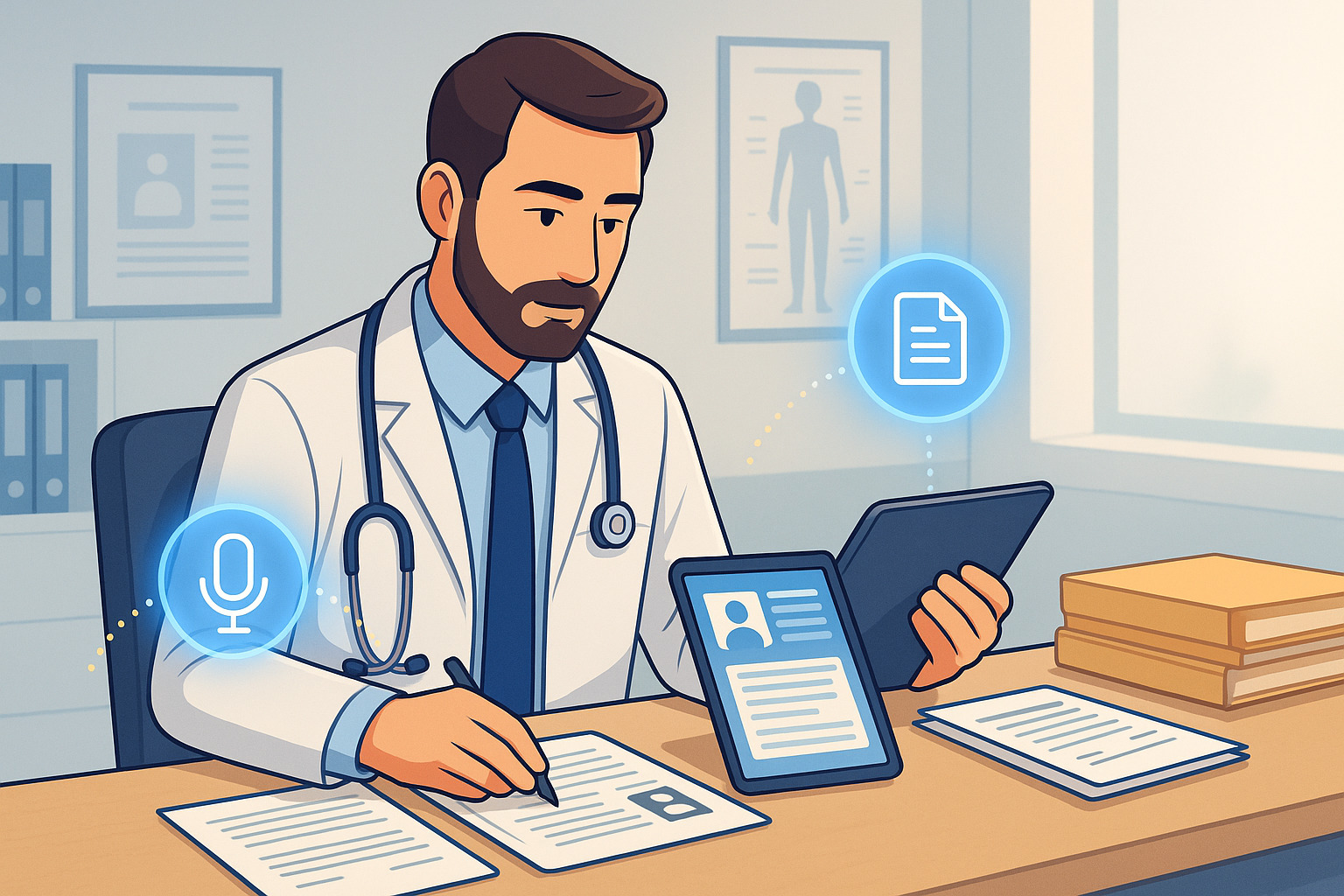Updated on: September 12, 2025
In every hospital, clinic, and consulting room, clinical documents form the foundation of care. From progress notes and SOAP notes to discharge summaries and follow-up records, these documents ensure continuity, compliance, and communication between providers.
Yet for clinicians, creating accurate clinical documents often feels like a burden. Studies show that doctors spend nearly two hours on documentation for every hour of patient interaction. This imbalance not only causes burnout but also increases the risk of errors, missed ICD-10 codes, and claim denials.
That’s where the DocScrib AI Scribe makes a difference. It streamlines the creation of clinical documents, ensuring they are accurate, ICD-10 ready, and seamlessly integrated inside your EHR.
What Are Clinical Documents?
Clinical documents are structured medical records that capture patient interactions, diagnoses, treatments, and outcomes. Common types include:
-
SOAP Notes (Subjective, Objective, Assessment, Plan)
-
Progress Notes
-
Discharge Summaries
-
Follow-Up Visit Records
-
Consultation Reports
-
Operative and Procedure Notes
These documents are critical for clinical decision-making, billing, legal compliance, and patient safety.
The Challenges of Manual Clinical Documentation
Even experienced clinicians struggle with manual documentation:
-
Time-Intensive: Typing or dictating notes consumes valuable time.
-
Error-Prone: Missed details and incomplete records reduce accuracy.
-
Coding Gaps: Without built-in ICD-10 assistance, miscoding is common.
-
Compliance Risks: Documentation errors may lead to denied claims or audits.
-
Burnout: Hours spent on paperwork contribute heavily to physician fatigue.
How DocScrib AI Scribe Transforms Clinical Documents
Real-Time Note Generation
DocScrib captures patient–clinician interactions and generates structured, ready-to-use clinical documents in real time.
ICD-10 Coding Built-In
Unlike traditional scribes, DocScrib suggests accurate ICD-10 codes alongside your documentation, ensuring compliance and billing accuracy.
EHR-Ready Integration
Clinical documents created with DocScrib sync directly with your EHR—eliminating the need for duplicate data entry.
Multi-Specialty Support
From psychiatry and orthopedics to cardiology and pediatrics, DocScrib adapts to specialty-specific documentation needs.
Time Savings and Burnout Reduction
By reducing documentation time by up to 70%, DocScrib gives clinicians back hours each week—helping restore balance to their professional and personal lives.
How to Create Clinical Documents with DocScrib AI Scribe
-
Start the Encounter → Open Docscrib within your EHR and begin the patient consultation.
-
Let the AI Listen → The DocScrib AI Scribe captures the conversation and converts it into structured text.
-
Review and Approve → Clinicians quickly review, edit if needed, and approve the document.
-
ICD-10 Suggestions Included → DocScrib highlights recommended codes for compliance and billing.
-
Save to EHR → With one click, the finalized clinical document is stored securely in the patient’s record.
DocScrib vs. Traditional Documentation Approaches
| Feature | DocScrib AI Scribe | Manual Documentation | Dictation Tools |
|---|---|---|---|
| Real-Time Note Creation | ✅ | ❌ | ⚠️ Limited |
| ICD-10 Coding Assistance | ✅ | ❌ | ❌ |
| EHR Integration | ✅ | ❌ | ⚠️ Partial |
| Accuracy & Compliance | High | Variable | Medium |
| Time Saved | Up to 70% | None | 20–30% |
Benefits of Using DocScrib for Clinical Documents
For Clinicians
-
Fast, accurate documentation
-
ICD-10 coding confidence
-
More time for patient care
For Hospitals
-
Fewer claim denials
-
Improved compliance and audit readiness
-
Operational efficiency gains
For Medical Consultants
-
Structured, ICD-10 ready documents
-
Easier data review across patients
-
Improved reporting quality
Getting Started with DocScrib
Implementation is simple:
-
Book a Demo → Schedule Your Demo Here
-
Integrate with Your EHR → Minimal setup required.
-
Start Documenting Smarter → Use DocScrib AI Scribe for your next patient encounter.
FAQs
Q1: What types of clinical documents can DocScrib generate?
Everything from SOAP notes and progress notes to discharge summaries and follow-up visit records.
Q2: Does it work for specialty practices?
Yes, DocScrib adapts to multiple specialties, including psychiatry, orthopedics, cardiology, and more.
Q3: How does it improve coding compliance?
By suggesting ICD-10 codes in real time, DocScrib reduces miscoding errors and claim denials.
Q4: Is Docscrib HIPAA-compliant?
Absolutely. Docscrib ensures data encryption, security, and HIPAA compliance.
Q5: How much time can Docscrib save per week?
Clinicians report saving 10–15 hours weekly on documentation tasks.
Conclusion: The Future of Clinical Documents is AI-Powered
In today’s fast-paced healthcare environment, clinical documents must be accurate, compliant, and efficient. The DocScrib AI Scribe delivers exactly that—real-time note generation, ICD-10 coding support, and seamless EHR integration.
The result? Happier clinicians, fewer denials, better patient care.
👉 Ready to transform how you create clinical documents?
